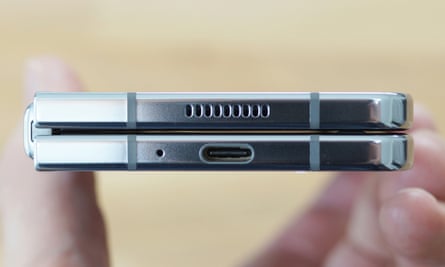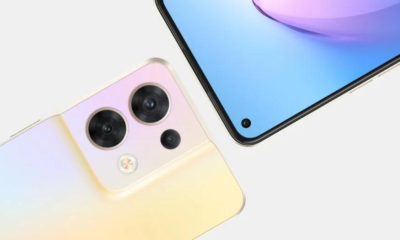Reviews
Samsung Galaxy Z Fold 5 Review.

Samsung Galaxy Z Fold 5 is the fifth iteration of the foldable tech, and it continues to be a leader among gadgets for those seeking the latest and greatest in terms of power. The Fold 5 from Samsung is no ordinary phone; it’s a device that can be thought of as a PC, tablet and phone all in one, conveniently able to be folded up and carried in your pocket. It is by far the most feature-packed android device available on the market.
Since the last year’s version, the design has been improved. It now folds flat when closed due to the same hinge design as the Z Flip 5, which is a major enhancement. The Galaxy is thinner and lighter by 10g than the previous edition, and the crease along the display fold is less noticeable. It is bulkier than a standard phone, yet weighs only 13g more than an iPhone 14 Pro Max. It is less of a burden in the pocket as compared to its competitor and is notably lighter.
The external display measuring 6.2 inches is a bit narrow resulting in a restricted keyboard area, however, its appearance is pleasing and it suffices for activities like texting, listening to music, and other minor tasks. When unfolded, the 7.6 inch internal display is a sight to behold when tackling more laborious tasks.
Samsung states that this year’s model is brighter, making it easier to combat glare. They also mention that its new design increases its strength by 25% compared to the prior version, yet it is still more delicate than typical tablet glass, so it must be handled with care.
Features of Galaxy Z Fold 5
- Display: 6.2in HD+ Amoled with a 120Hz refresh rate
- Processor: Qualcomm Snapdragon 8th Generation Processor
- Memory: 12GB of memory
- Storage Capacity: Offered in 256, 512GB, and 1TB
- Software System: The OS is based on Android 13 and features the One UI 5.1 interface.
- Cameras: 50MP wide-angle, 12MP ultra-wide, 10MP 3x telephoto; 10MP and 4MP front-facing
- Connectivity: 5G, dual SIM, eSIM, USB-C, WiFi 6E, Near Field Communication, Bluetooth 5.3, and Global Navigation Satellite System.
- Resistance to water: IPX8 (1.5m for a half hour)
- Measurement when folded: 13.4mm thick, 67.1mm wide, and 154.9mm long.
- Measurements when unfolded: 6.1mm thick, with a width and length of 154.9mm and 129.9mm respectively.
- The Weight: 253 grams
Long-Running
The Fold 5 has a USB-C port which can be used to connect to external displays and other equipment. Using a power adaptor of 25W or higher (not included), the phone can be recharged in around 72 minutes. The battery life of this model is a vast improvement upon the previous year’s, with a runtime of around 48 hours when both the interior and exterior displays are used for a period of six hours. This is much longer than its primary competitors and on par with the top-tier regular phones.
Software of Strength
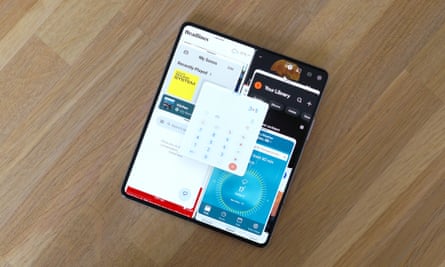
At any given time, the Z Fold 5 can simultaneously display up to three different applications, however more than four can be a bit challenging to handle.
Samsung’s One UI 5.1 is the major factor that set it apart. This software, built on the Android 13 platform, enables users to simultaneously utilise three apps in a split-screen layout with the option of floating windows on top for those who require a higher degree of productivity.
The Fold 5 is equipped to handle Samsung’s S Pen stylus, a feature that none of the other foldable devices can compete with. The taskbar situated on the bottom of the screen makes it easy to use multiple applications simultaneously.
The Pixel Fold provides much more selection when it comes to deciding how it works. For instance, you can customize a different home screen layout for the external and internal displays. This enables you to put phone applications on the small display and tablet applications on the large one. Furthermore, you can also select which applications stay open and appear on the small screen when you close them on the main screen, which is especially useful for having maps ready on the go.
Display Types
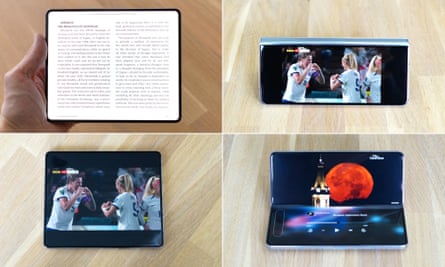
The hinge is designed to keep the screen open in a range of different angles, making it useful for consuming media in various different positions.
The latest “Flex Mode” panel offers an upgrade by permitting an app to be pushed to the top half of the display when it is folded in an L-shape. In the case of most video apps, this presents playback controls, including a progress bar and skip buttons, on the bottom half, with the video playing on top. With other types of apps, it can turn into a trackpad for a mouse cursor – a bit like a miniature laptop.
The Fold 5 from Samsung has a long-existing feature, called Dex mode, which allows it to be hooked up to a monitor, keyboard and mouse to generate an Android desktop computer. This could be all the computing power some people require.
Photographic Equipment
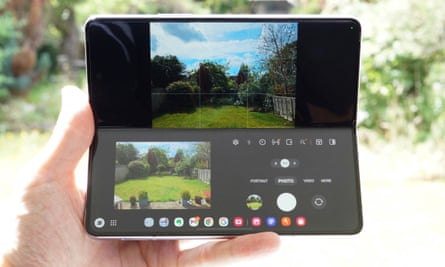
The Samsung Galaxy Z Fold 5’s camera app is usually more straightforward to use with the device closed. However, the phone’s interior display can be utilized in a folded or fully opened position for various creative shooting opportunities.
The Fold 5 has five cameras in total, similar to what was seen with its predecessor. This combination of cameras is useful, with three on the back, one standard one on the outside screen, and a 4MP one housed under the folding screen, which is only suitable for video calling.
In a variety of lighting conditions, the primary cameras, including the 3x telephoto, take good shots. The night mode is much faster than the prior models and the images are crisper. The Fold 5 still has numerous functions, such as taking selfies with the primary cameras and the option of propping it up and taking hands-free photos and videos.
Advantages of Samsung Galaxy Z Fold 5
Combines a phone and tablet into one, offers strong multitasking abilities, displays a phone-like screen on the outside, boasts a great tablet screen, offers high performance, provides excellent battery life, is water resistant, has no gap when closed, and is lightweight.
Disadvantages Samsung Galaxy Z Fold 5
Incredibly expensive, more delicate than a typical device, and expensive to repair, lacks dust resistance, thicker than the average phone, and not a huge improvement over the previous model.
The Samsung Galaxy Z Fold 5 is a fantastic device to take on the go. When partially folded, the Flex Mode feature allows for a video on YouTube to be easily watched, similar to a mini laptop.
Reviews
Xiaomi Redmi Note 13R Specifications

The Xiaomi Redmi Note 13R was officially announced on May 17, 2024, and has been available for purchase since the same day.
Design and Build
The Redmi Note 13R features a sleek design with dimensions of 168.6 x 76.3 x 8.2 mm and a weight of 205 grams. It boasts a glass front, a plastic frame, and a glass back, providing a premium feel while maintaining durability. The device supports dual Nano-SIM cards with dual standby and is rated IP53 for dust and splash resistance.
Display
Equipped with a 6.79-inch IPS LCD screen, the Redmi Note 13R offers a high refresh rate of 120Hz and a brightness of 550 nits. The display resolution is 1080 x 2460 pixels, resulting in a sharp density of approximately 396 ppi and an impressive screen-to-body ratio of around 85.1%.
Performance
Running on Android 14 with Xiaomi’s HyperOS overlay, the Redmi Note 13R is powered by the Qualcomm SM4450 Snapdragon 4+ Gen 2 chipset built on a 4 nm process. Its octa-core CPU consists of 2×2.3 GHz Cortex-A78 cores and 6×1.95 GHz Cortex-A55 cores, paired with an Adreno 613 GPU for smooth graphics performance.
Memory and Storage
The smartphone offers multiple memory configurations:
– 128GB storage with 6GB or 8GB RAM
– 256GB storage with 8GB or 12GB RAM
– 512GB storage with 12GB RAM
All variants use UFS 2.2 technology for faster data access and storage efficiency. Note that there is no memory card slot available for expandable storage.
Camera System
The dual-camera setup on the rear includes:
– A 50 MP main sensor with an f/1.8 aperture, PDAF, and a pixel size of 0.64µm
– A 2 MP macro sensor with an f/2.4 aperture
This setup is complemented by features such as LED flash and HDR, and can record videos at 1080p@30fps. The front camera houses an 8 MP wide sensor capable of the same video recording quality.
Audio
For audio enthusiasts, the Redmi Note 13R includes a loudspeaker, a 3.5mm headphone jack, and supports 24-bit/192kHz Hi-Res audio.
Connectivity
The device supports a range of connectivity options, including:
– Wi-Fi 802.11 a/b/g/n/ac (dual-band)
– Bluetooth 5.3 with A2DP and LE
– GPS, GLONASS, GALILEO, and BDS for positioning
– NFC for contactless payments
– An infrared port for remote control functions
The device features a USB Type-C port for charging and data transfer.
Additional Features
The Redmi Note 13R includes several sensors, such as a side-mounted fingerprint sensor, an accelerometer, and a compass, along with virtual proximity sensing for enhanced user interaction.
Battery and Charging
The phone is equipped with a non-removable 5030 mAh battery, supporting 33W wired charging, ensuring long-lasting usage and quick recharge times.
Colors and Pricing
The Xiaomi Redmi Note 13R is available in three colors: Black, Blue, and Silver. It is priced at approximately 180 EUR, making it a competitive option in its segment.
In summary, the Xiaomi Redmi Note 13R combines robust performance, a versatile camera system, and a high-refresh-rate display, all within a budget-friendly package.
Reviews
OPPO Reno 12 Series: Design, Launch Date and Specifications

OPPO has officially unveiled the front image rendering of its highly anticipated Reno 12 series of smartphones. This new series is set to introduce a fresh wave of innovation and design to the market. According to OPPO, the Reno 12 series incorporates a built-in anti-accidental touch algorithm designed to prevent unintended screen interactions. Additionally, the company has optimized the device’s ergonomics, ensuring it “feels good when held horizontally or vertically.” The official launch date for the Reno 12 series is set for May 23rd.
Design and Display
The Reno 12 series features a distinctive “four-curve soft-edge straight screen” design, akin to the “equal-depth slightly curved screen” concept. The screen curves gently on all four sides, giving it a straight-screen appearance from the front. This design not only enhances the phone’s aesthetic appeal but also improves grip comfort and usability. Available in two colors—silver and purple—the Reno 12 series exudes sophistication and elegance. The metallic purple variant, in particular, offers a smooth, gemstone-like feel under a glossy glass finish.
The Reno 12 Pro model boasts a 6.7-inch 1.5K 120Hz equal-depth quad-curved screen. This model is expected to feature a curved glass back and an IP65 rating for dust and water resistance. OPPO’s innovative system-level technology enhances the phone’s fluency and stability, promising a smooth user experience even after 48 months of use. The device’s 3D curved design ensures that both the screen and back cover fit comfortably in hand, providing an exceptional feel.
Performance and Cameras
The Reno 12 series includes the standard Reno 12, equipped with a MediaTek Dimensity 8250 processor, and the Reno 12 Pro, which features the more advanced Dimensity 9200 + Starspeed processor. These processors ensure fast performance, efficient battery life, and seamless multitasking capabilities.
The Reno 12 Pro’s camera setup includes a 50-megapixel JN5 front camera, a 50-megapixel IMX890 main camera, an 8-megapixel ultra-wide-angle lens, and a 50-megapixel JN5 2x telephoto lens. This quad-camera configuration is designed to capture high-quality images and videos, making it an attractive option for photography enthusiasts.
Battery and Charging
The Reno 12 series is powered by a large 5000mAh battery, providing all-day battery life. The series also supports 80W fast charging, allowing users to quickly recharge their devices. This feature is particularly beneficial for heavy users who need to keep their phones charged throughout the day.
Special Features
A standout feature of the Reno 12 series is its support for the Live Photo function on the Android platform. This feature addresses common issues with live photos on Android, offering a more seamless and enjoyable photography experience. The series also supports wireless Bluetooth calls, enabling users to make hands-free calls with ease.
The OPPO Reno 12 series marks a significant upgrade from its predecessors, offering a unique design, powerful performance, and advanced camera capabilities. The “four-curve soft-edge straight screen” design is likely to appeal to users who value both aesthetics and functionality. Additional features like the Live Photo function and wireless Bluetooth calls enhance the phone’s overall appeal, making it a compelling choice for those seeking a feature-rich smartphone. As the launch date approaches, tech enthusiasts and consumers are eagerly awaiting the opportunity to experience the Reno 12 series firsthand.
Reviews
Sony Xperia 1 VI Set for Unveiling With a Remarkable Camera

Sony’s latest flagship smartphone, the Sony Xperia 1 VI, has made its grand entrance, boasting a plethora of features tailored to cater to photographers and audiophiles alike. Released on May 15, 2024, the Xperia 1 VI promises to deliver an exceptional user experience, blending cutting-edge technology with Sony’s renowned craftsmanship.
Design and Display
Crafted with a sleek glass back adorned with a “textural rear panel finish” for enhanced grip, the Xperia 1 VI exudes elegance and functionality. Available in three sophisticated shades – Khaki Green, Platinum Silver, and Black – the device features a durable metal frame and a dedicated shutter key, catering to photography enthusiasts. Moreover, with dimensions of 162 x 74 x 8.2mm and weighing just 192g, the Xperia 1 VI strikes a perfect balance between portability and comfort.
Protected by Gorilla Glass Victus 2 on the front and Gorilla Glass Victus on the back, the device ensures robust durability and resistance to scratches. Its 6.5-inch OLED display, boasting a 19.5:9 aspect ratio, captivates users with vibrant visuals and immersive viewing experiences. Despite a downgrade in resolution to FHD+ (1080 x 2340), the Xperia 1 VI’s screen offers improved brightness and features AI-driven enhancements for optimal contrast, color, and clarity. Additionally, its variable refresh rate, ranging from 1Hz to 120Hz, guarantees seamless performance across various applications and activities.
Camera and Battery
The highlight of the Xperia 1 VI lies in its remarkable camera capabilities, particularly its 12MP telephoto lens, enabling users to zoom from 85mm to 170mm for unparalleled versatility. Complemented by a 48MP main sensor, a 12MP ultra-wide lens, and a 12MP front-facing camera, the device excels in capturing stunning photographs and videos in any setting. Equipped with AI-driven autofocus and image processing technologies, the Xperia 1 VI ensures superior image quality and precision, making every shot a masterpiece.
In terms of battery life, the Xperia 1 VI impresses with its 5,000mAh battery, delivering up to two days of usage under typical conditions and up to 36 hours of continuous video playback. Enhanced by Xperia Adaptive Charging technology, the device prolongs battery lifespan while supporting wireless charging and reverse wireless charging functionalities, ensuring uninterrupted usage throughout the day.
Specs and Features
Powered by a Snapdragon 8 Gen 3 chipset, coupled with 12GB of RAM and 256GB of storage, the Xperia 1 VI promises blazing-fast performance and ample storage for multitasking and multimedia consumption. Running on Android 14, the device guarantees seamless navigation and access to the latest features and updates.
Boasting a microSD card slot, a rarity among high-end handsets, the Xperia 1 VI offers expandable storage options for added convenience. Furthermore, with a commitment to three years of Android updates and four years of security patches, Sony ensures long-term reliability and security for its users.
Beyond its impressive hardware specifications, the Xperia 1 VI incorporates a host of software features tailored to enhance user experience. From an FPS optimizer for optimized gaming performance to advanced audio technologies such as High-Resolution Audio and LDAC support, the device caters to the diverse needs of modern consumers. Additionally, with its Music Pro feature leveraging AI to deliver studio-quality sound, the Xperia 1 VI redefines the audio experience on a smartphone.
In conclusion, the Sony Xperia 1 VI emerges as a powerhouse of innovation, combining cutting-edge technology with premium design aesthetics to deliver an unparalleled smartphone experience. With its focus on photography, audio excellence, and overall performance, the Xperia 1 VI stands poised to captivate users and elevate the standards of flagship smartphones in 2024 and beyond.
-

 Tech News7 days ago
Tech News7 days agoOnePlus 13 and 13R Potential Designs Unveiled
-

 Tech News3 days ago
Tech News3 days agoAndroid to Introduce Theft Detection Lock: Detecting When Your Phone is Snatched
-

 Tech News6 days ago
Tech News6 days agoSony Xperia 1 VI Camera Sensors Revealed
-

 Tech News7 days ago
Tech News7 days agoApple Nearing Deal with OpenAI to Integrate Generative AI Features into iOS 18
-

 Reviews4 days ago
Reviews4 days agoSony Xperia 1 VI Set for Unveiling With a Remarkable Camera
-

 Tech News6 days ago
Tech News6 days agoGoogle Pixel 9 Series to Introduce Four Distinct Models
-

 Reviews2 days ago
Reviews2 days agoXiaomi Redmi Note 13R Specifications
-

 Reviews3 days ago
Reviews3 days agoOPPO Reno 12 Series: Design, Launch Date and Specifications

